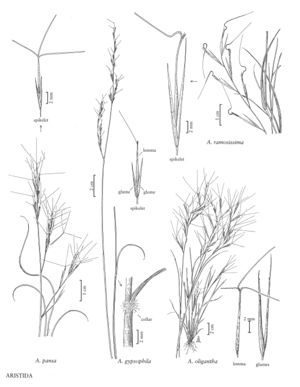Aristida ramosissima
Plants annual. Culms 20-60 cm, wiry. Leaves cauline; sheaths usually shorter than the internodes, mostly glabrous, sparsely hairy near the summit; collars hispidulous, occasionally glabrous; ligules 0.2-0.5 mm; blades 3-22 cm long, to 2 mm wide, flat to involute, glabrous abaxially, sparsely pilose adaxially, without a prominent midrib but with a thickened vein near each margin, pale to gray-green, sometimes slightly glaucous. Inflorescences paniculate or racemose, 5-12 cm long, 2-4 cm wide; primary branches barely developed. Spikelets appressed to slightly divergent from the axillary pulvini. Glumes subequal, apices bifid, awned from the sinuses; lower glumes (9)11-16 mm, 3-7-veined, awns 0.5-2(4) mm; upper glumes 11-18 mm, 1-3-veined, awns 3-7 mm; calluses 0.4-1 mm; lemmas (8)15-20(22) mm, dark, occasionally banded or spotted, apices narrowed but not beaklike; central awns 12-25 mm, bases with a semicircular bend; lateral awns 1-4 mm, erect, occasionally lacking; anthers 3, about 3 mm, brown. Caryopses 9-11 mm, dark brown to black. 2n = unknown.
Distribution
Tenn., Okla., Tex., La., Mo., Ohio, Kans., Ark., Ill., Miss., Ind., Iowa, Ky.
Discussion
Aristida ramosissima grows in open, dry, sterile ground, fallow fields, and roadsides. It is restricted to the United States.
Selected References
None.
